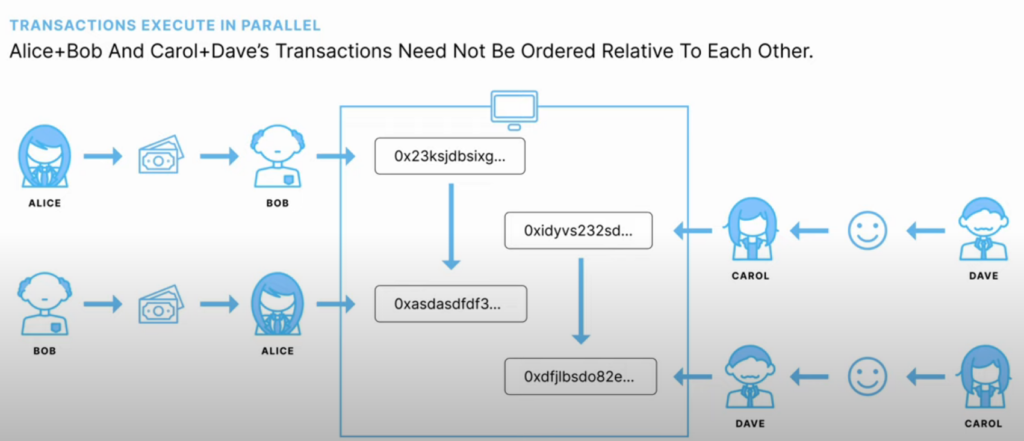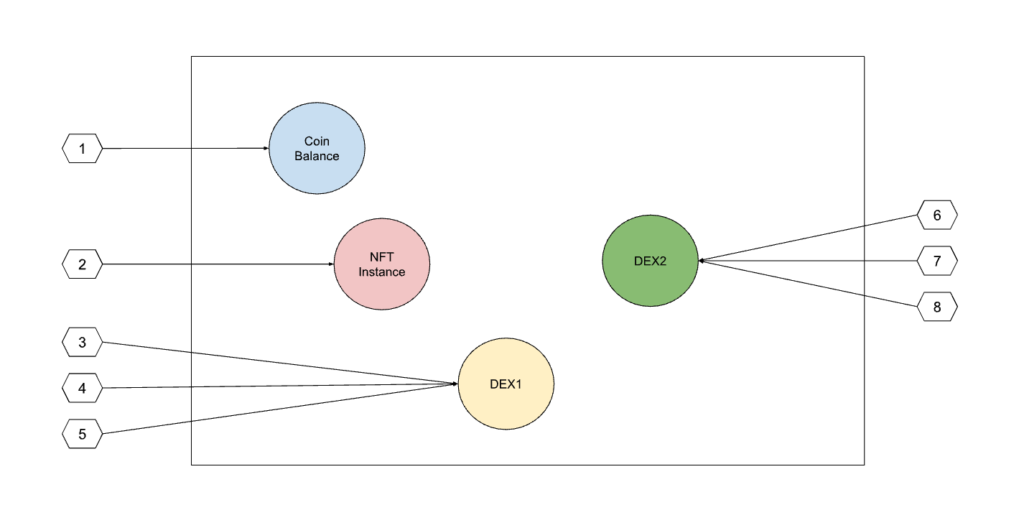What is Sui? Blockchain Project From Ex-Meta Developers

In late 2022, a new layer-1 blockchain was launched amidst the bear market, Aptos. Aptos is a crypto project born from a team who previously worked at Meta (Facebook). This development team used to work on Meta’s blockchain project, Diem. When Diem was canceled, the development team split and created crypto projects independently such as Aptos. Sui is also a project from the ex-Diem team. Then, what is Sui? What are the advantages of Sui and how does it work? This article will explain the Sui crypto project.
Article Summary
- 🌊 Sui is a layer-1 permissionless blockchain from a team of ex-Meta developers. In addition, Sui is a smart contract platform using Sui Move that can fulfill various needs in one ecosystem.
- ⚙️ Sui has fundamental differences from other blockchains. In general, blockchains store transaction data sequentially, from the first to the most recent. Sui processes transactions based on objects, rather than subjects (like addresses or accounts). There are two types of object transactions: single-owner and shared objects.
- 🧠 One of Sui’s unique characteristics is parallel transaction execution. Validators can process single-owner objects without a specific order and without going through the consensus engine. Shared objects are processed sequentially if they are related to the same object and require Sui consensus protocol validation. These two types of objects have different transaction processing lanes and can be processed simultaneously.
- 🏎️ Sui scales horizontally by opening as many transaction validation lanes as possible. These transaction lanes can grow linearly with the number of validators in the network.
- 🦈 Bullshark and Narwhal are two DPoS consensus protocols of Sui. Both have different roles in processing transactions. Transactions that go through Sui’s consensus engine are ordered based on causality and the order of transactions if they interact with the same object.
What is Sui?
Sui is a layer-1 permissionless blockchain from a team of ex-Meta developers. Sui is a smart contract platform that can fulfill multiple needs in one ecosystem. Announced alongside Aptos, Sui continues the trend of layer-1 crypto projects created to rival Ethereum. The development team claims that the network can process more than 100,000 transactions per second (TPS). In addition, one of Sui’s unique characteristics is the parallel execution of transactions through object-centric processing. This transaction model makes Sui very different from the typical blockchain.

As mentioned, Sui’s founding team is filled with ex-Diem Meta developers. The team also creates the Move programming language. Since its announcement, Sui has gone through two funding rounds, series a and b, totaling $336 million dollars. This is similar to what Aptos raise, which is $350 million.
Currently, Sui has just completed phase two of testnet. In this test, 41 validators manage to process 36.5 million transactions from 1.6 million addresses.
How Does Sui Work?
Like other layer-1 blockchains, Sui uses a proof-of-stake or PoS architecture. PoS networks utilize validators to process transactions. In addition, Sui also has smart contract capabilities using the Move programming language which is similar to the Rust language (Near, Solana, and Polkadot). Sui modifies the Move programming language to adapt it to Sui’s needs (called Sui Move).
Sui and Aptos are the only ones who use the Move programming language so the number of developers who master this language is quite limited. However, Move's architecture is based on Rust so Solana, Near, and Polkadot developers can use Move without starting from scratch.
Sui has fundamental differences from other blockchains. In general, blockchains store transaction data chronologically, from the first to the most recent transaction. Bitcoin, Ethereum, and Solana work like this. The majority of transactions on the network are processed without any strict order. However, some transactions are organized by causality, where transactions 1, 2, and 3 are related. In this case, Sui stores the history of these interrelated transactions from genesis to the latest.
1. Object-Based Transaction Processing

So, why did Sui do this? Why doesn’t Sui sort transactions chronologically? This is because the network processes transactions based on objects, not the subject (like an address or account). Each object can only be processed by its owner’s address so this system is as secure as any other blockchain. In Sui, object-based transactions are divided into two: single-owner objects and shared objects.
Objects are basically data on the Sui network. Each object has its own ID.
Single-owner objects are individual objects that are used in transactions one at a time such as minting NFTs and sending or receiving assets. Only one address can own single-owner object but an address can hold multiple objects. Meanwhile, shared objects are objects that are used by more than one user simultaneously such as auctions and DEXs with order books. Multiple addresses can own a single shared object.
The system processes these objects in different ways. Validators can instantly process single-owner objects without reaching a consensus and without a specific order. Sui uses a system based on Fastpay for processing this type of object. Meanwhile, shared objects go through the Bullshark and Narwhal consensus mechanisms. Shared objects have their own transaction history.
The transaction processing of these two types of objects is like different lanes that are parallel to each other.
2. Parallel Transactions and Horizontal Scalability

Object-based transaction processing is Sui’s primary advantage, namely parallel transaction execution (parallel processing). As shown in the figure above, transactions can be processed in no particular order if the objects are not related to each other. So, in this case, validators do not need to communicate with each other.
Basically, each transaction runs on different lanes which Sui calls a multi-lane approach. Validators can process independent transactions without the need for synchronization at the network level. Thus, there are actually no “blocks” on Sui’s network as transactions go through one at a time. This allows reduced latency and time-to-finality.
The transaction processing flow of single-owner objects does not require communication between validators so each validator can process it quickly. In this case, the quorum driver (which can be a Full node validator, RPC provider, or custodial wallet) checks the validity of the transaction and adds signatures to valid transactions. Then, the quorum driver collects signatures greater than or equal to 2/3 of the total staking and converts them into certificates. Then, a set of validators receive these certificates, process them, and return them to the quorum driver. A transaction that has been returned is complete.
Sui uses this system because the majority of transactions are unrelated to each other, so the chronological ordering of transactions into blocks is unnecessary and wasteful. Storing chronologically is a huge burden on the network and Sui wants to avoid this.
In the case of shared objects, when the validator receives a certificate, it uses Narwhal to pass the certificate to Bullshark for sorting. Narwhal and Bullshark are a mempool based on a DAG system as well as a consensus mechanism that is already BFT (Byzantine Fault Tolerant).
Sui’s system removes a critical bottleneck in most blockchains: the need to achieve global consensus on a chronologically ordered list of transactions. Thus, Sui can horizontally scale by opening as many lanes as possible. These transaction lanes can grow linearly with the size of validators in the network. In addition, validators can also increase their machine capabilities and open more transaction processing lanes. Horizontal scalability is one of Sui’s signature advantages because does not have to store and maintain sequential data storage on the chain (like Bitcoin and Ethereum).
3. Move Programming Language
Sui Move is the tool to define, create, and manage programmable Sui objects to represent assets at the user level. The team modifies Move to incorporate the object system, adding new functionality while imposing additional constraints to improve security. Thus, the Sui Move is born. Sui Move is the programming language for creating smart contracts.
The programming language is also built in conjunction with Sui Prover, a tool to check codes in smart contracts and ensure they are secure and work properly. Sui Prover is useful in various stages of testing when creating smart contracts. This will make it easier for developers to make their applications secure.
The Sui Move Package is a smart contract in Sui. A Package contains various separate modules that each define a specific function. The module system makes implementation and optimization easier. When developers update a module, all smart contracts associated with it will automatically use the latest version.
Sui publishes a tutorial on how to create smart contracts in Move.
4. Narwhal and Bullshark Consensus Mechanism

Sui’s consensus mechanism uses two DAG-based protocols, Narwhal and Bullshark. Both of these consensus protocols use Delegated Proof-of-Stake (DPoS). These two protocols have different functions in the stages to reach a consensus. As mentioned before, Sui’s consensus mechanism is only used in processing shared objects transactions and is organized based on causality, not chronologically.
Pintu Academy has an article on Proof-of-Stake (PoS) systems. Read more to know about this system.
There are not many crypto projects that use the DAG as their consensus mechanism. Another crypto project that uses DAG is Fantom. DAG has proven to have good performance and security. However, it is more difficult to decentralize.
Sui uses Narwhal as a mempool and Bullshark as a consensus engine to sort transactions that require causality, synchronize transactions between validators, and periodically check the network state.
So, here’s what each protocol does in simple terms:
- Narwhal = ensures the availability of data sent to consensus.
- Bullshark = agreeing on a specific order of this data.
What are the advantages of Sui?
- 🏎️ Parallel Transaction Processing: Sui processes transactions based on objects, not accounts or addresses. This system allows parallel transaction processing where objects can be processed in different lanes independently. These parallel transactions increase TPS, reduce latency, and make the network more efficient.
- 🧠 Horizontal Scalability: With Sui’s parallel system, the Sui network is horizontally scalable. More transaction lanes are possible as the number of validators grows. The machine power of each validator can also determines how many transaction lanes the validator can open. So, this type of scalability is essentially limitless.
- 🖥️ Sui Move: Sui Move is a modified version of the Move programming language. This programming language is Sui’s tool for creating and modifying smart contracts. The advantage of Sui Move lies in its security.
- 🦈 DAG-Based Consensus Mechanism: Sui uses DAG-based Bullshark and Narwhal consensus mechanisms. These consensus protocols can process transactions quickly and ensure low gas fees. So, Sui’s consensus mechanism is very efficient as it is only used for shared object transactions.
How to Buy SUI in Pintu
Sui has yet to unveil the details regarding the launch of the SUI coin. However, you can invest in other cryptocurrencies such as BTC, BNB, ETH, and others through Pintu in a safe and easy manner. The Pintu app is compatible with various popular digital wallets like Metamask to make your transactions easier.
Download the Pintu cryptocurrency app on the Play Store and App Store now!
Aside from transactions, you can also learn more about crypto through various Pintu Academy articles updated weekly! All Pintu Academy articles are for educational purposes and not financial advice.
References
- Macevoy.eth, SUI — A DEEP DIVE — mac’Evoy, Mirror.xyz, accessed on 21 March 2023.
- Gustavo Lobo, Move With Sui, The TIE Research, accessed on 21 March 2023.
- About Sui | Sui Docs, accessed on 22 March 2023.
- How Sui Works | Sui Docs, accessed on 22 March 2023.
- How Sui Differs from Other Blockchains | Sui Docs, accessed on 24 March 2023.
- Narwhal and Bullshark, Sui’s Mempool and Consensus Engines | Sui Docs, accessed on 24 March 2023.
Share


